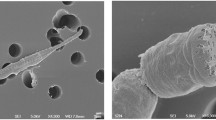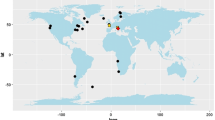Abstract
Hippolyte inermis Leach 1915 is a protandric shrimp largely distributed in Posidonia oceanica meadows and other Mediterranean seagrasses. Previous studies demonstrated several physiological peculiarities, such as absence of female gonadic buds in adult males (the new female gonad is produced starting from few undifferentiated cells), the consequent absence of an ovotestis, 2 yearly periods of reproduction with different population structures (a spring outburst producing both males and primary females, and a fall reproduction producing mainly males), and a process of sex reversal influenced by the diatom food ingested. We performed several laboratory analyses to compare the effects of various species of benthic diatoms, in order to test the effect of different diatoms and provide information on the mechanism of action of the ingested compounds. In addition, we performed molecular tests (TUNEL) and TEM observations, to check the hypothesis that the effect of benthic diatoms may be mediated by a process of apoptosis acting on the male gonad. The results obtained allowed for a ranking of a series of benthic diatoms according to their effects on sex reversal, and a confirmation of the striking effect of Cocconeis sp. diatoms, which are able to trigger the appearance of primary females. We also demonstrated the presence of apoptosis both in the male gonad and in the androgenic glands of postlarvae. The effect is species specific, strictly localized to the male gonad and androgenic gland, and limited to a very short period of time, from the 5th to the 12th day of postlarval development.






Similar content being viewed by others
References
Abdu U, Davis C, Khalaila I, Sagi A, (2002) The vitellogenin cDNA of Cherax quadricarinatus encodes a lipoprotein with calcium binding ability, and its expression is induced following the removal of the androgenic gland in a sexually plastic system. Gen Comp Endocrinol 127:263–272
Adiyodi G, Adiyodi G (1970) Endocrine control of reproduction in decapod crustacea. Biol Rev 45:121–165
Austin CM, Meewan M (1999) A preliminary study of primary sex ratios in the freshwater crayfish, Cherax destructor Clark. Aquaculture 174:43–50
Bauer RT (2000) Simultaneous hermaphroditism in caridean shrimps: a unique and puzzling sexual system in the Decapoda. J Crust Biol 20(2):116–128 Sp. Iss. SI
Bedini R, Canali MG, Baldi C (1997) Mimetismo criptico nei crostacei della prateria a Posidonia oceanica (L.) Delile. Biol Mar Medit 4(1):353–355
Bongiorni L, Pietra F (1996) Marine Natural Products for industrial application. Chem Ind 2:54–58
Broggini M, Marchini SV, Galliera E, Borsotti P, Taraboletti G, Erba E, Sironi M, Jimeno J, Faircloth GT, Giavazzi R, D’Incalci M (2003) Aplidine, a new anticancer agent of marine origin, inhibits vascular endothelial growth factor (VEGF) secretion and blocks VEGF-VEGFR-1 (flt-1) autocrine loop in human leukemia cells Molt-4. Leukemia 17:52–59
Buia MC, Gambi MC, Zupo V (2000) Structure and functioning of Mediterranean seagrass ecosystems: an overview. Biol Mar Medit 7(2):167–190
Calado R, Figueiredo J, Rosa R, Nunes ML, Narciso L (2005) Effects of temperature, density, and diet on development, survival, settlement synchronism, and fatty acid profile of the ornamental shrimp Lysmata seticaudata. Aquaculture 245(1–4):221–237
Charniaux-Cotton H (1954) Decouverte chez un Crustace Amphipode (Orchestia gammarella) d’une glande endocrine responsible de la differenciation des caracteres sexuels primaires et secondaires males. Comptes Rendus Acad Sci Paris 239:780–782
Charniaux-Cotton H (1960) Sex determination. In: Waterman TH (ed) Physiology of crustacea, 1. Academic Press, New York, pp 411–447
Charniaux-Cotton H, Payen G (1988) Crustacean reproduction. In: H Laufer, Downer RGH (eds) Endocrinology of selected invertebrate types. Alan R. Liss, New York, pp 279–303
Cobos V, Diaz V, Garcia-Raso JE, Manjòn-Cabeza ME (2005) Insights on the female reproductive system in Hippolyte inermis (Decapoda, Caridea): is this species really hermaphroditic? Invertebr Biol 124(4):310–320
d’Udekem d’Acoz C (1996) The genus Hippolyte Leach, 1814 (Crustacea: Decapoda: Caridea: Hippolytidae) in the East Atlantic Ocean and the Mediterranean Sea, with a checklist of all species in the genus. Zool Verhand 303:1–133
De Stefano M, Marino D, Mazzella L (2000) Marine taxa of Cocconeis on leaves of Posidonia oceanica, including a new species and two new varieties. Eur J Phycol 35(3):225–242
Dirsch VM, Kirschke SO, Estermeier M, Steffan B, Vollmar AM (2004) Apoptosis signaling triggered by the marine alkaloid ascididemin is routed via caspase-2 and JNK to mitochondria. Oncogene 23:1586–1593
Erba E, Bergamaschi D, Bassano L, Damia G, Ronzoni S, Faircloth GT, D’Incalci M (2001) Ecteinascidin-743 (ET-/l), a natural marine compound, with a unique mechanism of action. Eur J Cancer 37:97–105
Evan G, Littlewood T (1998) A matter of life and cell death. Science 281:1317–1322
Frankfurt OS, Krishan A (2001) Identification of apoptotic cells by formamide-induced DNA denaturation in condensed chromatin. J Histochem Cytochem 49:369–378
Gambi MC, Lorenti M, Russo GF, Scipione MB, Zupo V (1992) Depth and seasonal distribution of some groups of vagile fauna of the Posidonia oceanica leaf stratum: structural and trophic analyses. P.S.Z.N.I.: Mar Ecol 13:17–39
Gherardi F, Calloni C (1993) Protandrous hermaphroditism in the tropical shrimp Athanas indicus (Decapoda: Caridea), a symbiont of sea urchins. J Crust Biol 13(4):675–689
Ginsburger-Vogel T, Charniaux-Cotton H (1982) Sex determination. In: Abele LG (ed) The biology of Crustacea. Academic, Orlando, pp 257–281
Guillen Nieto JE (1990) Guia illustrada de los crustaceos decapodos del litoral alicantino. 316 pp. - Instituto del Cultura “Juan Gil-Albert” Publ., Alicante
Hannun YA (1997) Apoptosis and the dilemma of cancer chemotherapy. Blood 89:1845–1853
Hengartner MO (2000) The biochemistry of apoptosis. Nature 407:770–776
Ianora A, Poulet SA, Miralto A (1995) A comparative study of the inhibitory effect of diatoms on the reproductive biology of the copepod Temora stylifera. Mar Biol 121:533–539
Jimeno JM (2002) A clinical armamentarium of marine-derived anti-cancer compounds. Anticancer Drugs 13(1):15–19
Katakura Y (1989) Endocrine and genetic control of sex differentiation in the malacostracan Crustacea. Inv Rep Dev 16:177–182
Kaufmann SH, Earnshaw WC (2000) Induction of apoptosis by cancer chemotherapy. Exp Cell Res 256:42–49
Khalaila I, Weil S, Sagi A (1999) Endocrine balance between male and female components of the reproductive system in intersex Cherax quadricarinatus (Decapoda: Parastacidae). J Exp Zool 283:286–294
Khalaila I, Manor R, Weil S, Granot Y, Keller R, Sagi A (2002) The eyestalk-androgenic gland-testis endocrine axis in the crayfish Cherax quadricarinatus. Gen Comp Endocrinol 127(2):147–156
Le Roux A (1963) Contribution à l’étude du développement larvaire d’Hippolyte inermis Leach (Crustacée Décapode Macroure). Comptes Rendus Séanc Acad Sci Paris 256:3499–3501
Martin G, Sorokine O, Moniatte M, Bulet P, Hetru C, Van Dorsselaer A (1999) The structure of a glycosylated protein hormone responsible for sex determination in the isopod, Armadillidium vulgare. Eur J Biochem 262:727–736
Mazzella L, Buia MC (1989) Variazioni a lungo termine in alcuni parametri strutturali di una prateria a Posidonia oceanica. Nova Thalassia 10(1):533–542
Miralto A, Ianora A, Poulet SA (1995) Food type induces different reproductive responses in the copepod Centropages typicus. J Plankt Res 17:1521–1534
Miralto A, Ianora A, Poulet SA, Romano G, Laabir M (1996) Is fecundity modified by crowding in the copepod Centropages typicus? J Plankt Res 18:1033–1040
Miralto A, Barone G, Romano G, Poulet SA, Ianora A, Buttino I, Mazzarella G, Laabir M, Cabrini M, Giacobbe MG (1999) The insidious effect of diatoms on copepod reproduction. Nature 402(6758):173–176
Nagamine C, Knight AW, Maggenti A, Paxman G (1980) Effects of androgenic gland ablation on male primary and secondary sexual characteristics in the Malaysian prawn Macrobrachium rosenbergii (de Man) with first evidence of induced feminization in a non-hermaphroditic decapod. Gen Comp Endocrinol 41:423–441
O’Gorman DM, Cotter TG (2001) Molecular signals in anti-apoptotic survival pathways. Leukemia 15:21–34
Ohira T, Hasegawa Y, Tominaga S, Okuno A, Nagasawa H (2003) Molecular cloning and expression analysis of cDNAs encoding androgenic gland hormone precursors from two Porcellionidae species, Porcellio scaber and P. dilatatus. Zool Sci 20(1):75–81
Payen GG (1973) Etude descriptive des principales étapes de la morphogenèse sexuelle chez un crustacé décapode à développement condensé, l’Ecrevisse Pontastacus leptodactylus leptodactylus (Eschscholtz, 1823). Ann Embryol Morphog 6:179–206
Payen GG (1983) Endocrine regulation of male genital development in malacostraca. Am Zool 23(4):951–951
Poulet SA, Ianora A, Miralto A, Meijer L (1994) Do diatoms arrest embryonic development in copepods? Mar Ecol Prog Ser 111:79–86
Raff M (1998) Cell suicide for beginners. Nature 396:119–122
Regnault M (1969) Etude experimentale de la nutrition d’Hippolyte inermis Leach (Decapoda Natantia) au course de son developpement larvaire, au laboratoire. Internat Rev ges Hydrobiol 54:749–764
Reverberi G (1950) La situazione sessuale di Hippolyte viridis e le condizioni che la reggono. Bollettino Zoologico Italiano 4–6:91–94
Romano G, Russo GL, Buttino I, Ianora A, Miralto A (2003) A marine diatom-derived aldehyde induces apoptosis in copepod and sea urchin embryos. J Exp Biol 206(19):3487–3494
Sagi A (1988) The androgenic gland in crustacea-with emphasis on the cultured freshwater prawn Macrobrachium rosenbergii—A review. Israeli J Aquacult Bamidgeh 40(1):9–16
Sagi A, Khalaila I (2001) The crustacean androgen: a hormone in an isopod and androgenic activity in decapods. Am Zool 41:477–484
Sagi A, Milstein A, Eran Y, Joseph D, Khalaila I, Abdu U, Harpaz S, Karplus I (1997a) Culture of the Australian redclaw crayfish (Cherax quadricarinatus) in Israel, second growout season of overwintered populations. Israeli J Aquacult Bamidgeh 49(4):222–229
Sagi A, Snir E, Khalaila I (1997b) Sexual differentiation in decapod crustaceans: role of the androgenic gland. Invert Reprod Devel 31:55–61
Sagi A, Manor R, Segall C, Davis C, Khalaila I (2002) On intersexuality in the crayfish Cherax quadricarinatus: an inducible sexual plasticity model. Invert Reprod Devel 41:27–33
Schwartsmann G, Brondani da Rocha A, Berlinck RG, Jimeno J (2001) Marine organisms as a source of new anticancer agents. Lancet oncol 2:221–225
Schwartsmann G, Da Rocha AB, Mattei J, Lopes R (2003) Marine-derived anticancer agents in clinical trials. Expert Opin Investig Drugs 12:1367–1383
Taketomi Y., Nishikawa S, Koga S (1996) Testis and androgenic gland during development of external sexual characteristics of the crayfish Procambarus clarkii. J Crust Biol 16:24–34
Vaux DL, Korsmeyer SJ (1999) Cell death in development. Cell 96:245–254
Veillet A, Dax J, Vouax AM (1963) Inversion sexuelle et parasitisme par Bophyrina virbii (Walz) chez la crevette Hippolyte inermis (Leach). Comptes Rendus Séanc Acad Sci Paris 256:790–791
Zariquiei Alvarez R (1968) Crustaceos Decapodos ibericos. Investigation Pesquera 32:1–510
Zupo V (1994) Strategies of sexual inversion in Hippolyte inermis Leach (Crustacea Decapoda) from a Mediterranean seagrass meadow. J Exp Mar Biol Ecol 178:131–145
Zupo V (2000) Effect of microalgal food on sex reversal of Hippolyte inermis (Crustacea Decapoda). Mar Ecol Prog Ser 201:251–259
Zupo V (2001) Influence of diet on sex differentiation of Hippolyte inermis Leach (Decapoda: Natantia) in the field. Hydrobiologia 449:131–140
Acknowledgments
This research was partially conducted within the degree thesis of P. Messina. The confocal microscopy observations were conducted by Dr. Isabella Buttino. We thank Dr. A. Sagi and Dr. M. Williams for the critical revision of the English text and Dr. M. De Stefano for taxonomical advices on the selected diatoms. We are indebted to Dr. E. Aflalo for the fundamental contribution in the histological researches on H. inermis. Mr G. Iamunno performed the TEM preparations. Some specimens used for TUNEL analyses were cultivated and processed within the Pharmapox project, funded by the European Commission (EU 4800) and coordinated by V. Zupo. The text was improved thanks to the suggestions of two anonymous reviewers. The correctness of English language was kindly enhanced by Mrs. R. Messina.
Author information
Authors and Affiliations
Corresponding author
Additional information
Communicated by R. Cattaneo-Vietti, Genova.
Rights and permissions
About this article
Cite this article
Zupo, V., Messina, P. How do dietary diatoms cause the sex reversal of the shrimp Hippolyte inermis Leach (Crustacea, Decapoda). Mar Biol 151, 907–917 (2007). https://doi.org/10.1007/s00227-006-0524-9
Received:
Accepted:
Published:
Issue Date:
DOI: https://doi.org/10.1007/s00227-006-0524-9




